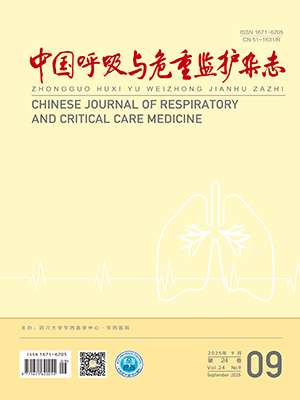| 1. |
Senter J, Wagner K, Gabryszewski SJ, et al. Severe pneumonia in a previously healthy infant. Clin Pediatr (Phila), 2023, 62(12): 1595-1598.
|
| 2. |
张连芳, 谢榕城, 林雪烽, 等. 重症监护室内重症肺炎患者新发血栓事件和病死率的研究分析. 中国呼吸与危重监护杂志, 2024, 23(1): 7-14.
|
| 3. |
Lee K, Choi J, Choi BK, et al. Picroside II isolated from Pseudolysimachion rotundum var. Subintegrum inhibits glucocorticoid refractory serum amyloid A (SAA) expression and SAA-induced IL-33 secretion. Molecules, 2019, 24(10): 2020-2031.
|
| 4. |
王亚静, 张静, 宋卫卫, 等. 大黄素通过调控ROS/TXNIP/NLRP3轴介导的细胞焦亡途径减轻重症肺炎大鼠肺损伤. 中国病理生理杂志, 2021, 37(7): 1240-1245.
|
| 5. |
卢晶, 苑萌, 冯学辉, 等. 白藜芦醇调控ROS/NLRP3/Caspase1通路介导的细胞焦亡对重症肺炎大鼠肺损伤的保护作用. 分子诊断与治疗杂志, 2023, 15(5): 888-891,896.
|
| 6. |
Piao X, Sui X, Liu B, et al. Picroside II improves severe acute pancreatitis-induced hepatocellular injury in rats by affecting JAK2/STAT3 phosphorylation signaling. Biomed Res Int, 2021, 2021(1): 9945149-9945160.
|
| 7. |
Garg M, Johri S, Sagar S, et al. Cardiolipin-mediated PPARγ S112 phosphorylation impairs IL-10 production and inflammation resolution during bacterial pneumonia. Cell Rep, 2021, 34(6): 108736-108773.
|
| 8. |
刘雪青, 孔立, 任英莉, 等. 胡黄连苷-Ⅱ对各脏器保护作用的研究进展. 世界最新医学信息文摘(连续型电子期刊), 2019, 19(96): 118-119,122.
|
| 9. |
王明霞, 蔡雪峰, 林静, 等. 胡黄连苷Ⅱ通过激活自噬作用抑制泡沫细胞的形成与炎症反应. 中国免疫学杂志, 2022, 38(3): 313-318.
|
| 10. |
刘浩, 刘修恒, 王磊, 等. 胡黄连苷Ⅱ可通过增强自噬抑制炎症和氧化应激减轻大鼠肾缺血再灌注损伤. 武汉大学学报(医学版), 2019, 40(2): 203-207.
|
| 11. |
秦玉春, 邝向东, 蔡林再, 等. 双氢青蒿素减轻慢性阻塞性肺疾病(COPD)模型大鼠肺损伤. 基础医学与临床, 2023, 43(3): 427-432.
|
| 12. |
Xue Z, Xi Q, Liu H, et al. miR-21 promotes NLRP3 inflammasome activation to mediate pyroptosis and endotoxic shock. Cell Death Dis, 2019, 10(6): 461-474.
|
| 13. |
张晓, 宋作艳, 李秋杰, 等. 大鼠机械通气相关性肺损伤时蛋白激酶Cδ与细胞焦亡的关系. 中华麻醉学杂志, 2020, 40(5): 581-584.
|
| 14. |
李瑞晟, 王琴, 李晶晶, 等. PTEN抑制剂BPV通过下调细胞焦亡水平改善LPS诱导的急性肺损伤. 中国免疫学杂志, 2023, 39(5): 911-916.
|
| 15. |
孙立燕, 刘泽茹, 苏永胜, 等. 车叶草苷调节NLRP3/Caspase-1/GSDMD信号通路对脓毒症大鼠肺组织细胞焦亡的影响. 天津医药, 2023, 51(6): 607-613.
|
| 16. |
An X, Zhang Y, Cao Y, et al. Punicalagin protects diabetic nephropathy by inhibiting pyroptosis based on TXNIP/NLRP3 pathway. Nutrients, 2020, 12(5): 1516-1526.
|
| 17. |
刘艳辉, 范永会, 王建文. 重症肺炎患者外周血NLRP3炎性小体表达水平的变化及临床意义. 分子诊断与治疗杂志, 2022, 14(6): 970-974.
|
| 18. |
Ren Y, Yang Z, Sun Z, et al. Curcumin relieves paraquat-induced lung injury through inhibiting the thioredoxin interacting protein/NLR pyrin domain containing 3-mediated inflammatory pathway. Mol Med Rep, 2019, 20(6): 5032-5040.
|
| 19. |
Wu X, Wu L, Wu Y, et al. Heme oxygenase-1 ameliorates endotoxin-induced acute lung injury by modulating macrophage polarization via inhibiting TXNIP/NLRP3 inflammasome activation. Free Radic Biol Med, 2023, 194(1): 12-22.
|




